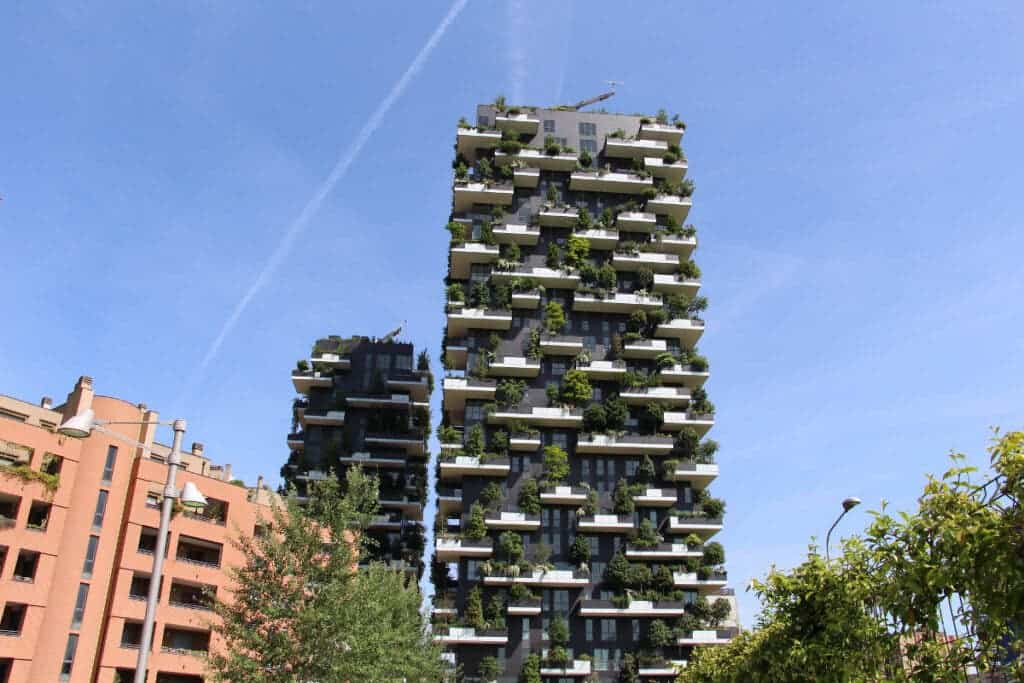
If you get the chance to travel in a time machine, how would you actually know it worked? Sure, there could be clues from what people are wearing, or maybe there’s flying cars, but most likely, the architecture around you would be your first hint that yes you are in a different time period.
Architecture has changed dramatically throughout human history. Currently, most of the man-made structures that you see around today (especially in urban areas) fall under the umbrella of modern architecture. Modern architecture first emerged in the late 1880s, though in most countries, it started later. Modern architecture was based on innovations in material and structure design and it completely transformed the way that buildings were designed and built. New materials and techniques allowed engineers to build taller, stronger, and lighter buildings, opening up the vertical axis in an unprecedented way. This architectural style for the first time enabled humans to construct tall skyscrapers, strong steel bridges, shiny glass buildings, and later led to the birth of post-modern architecture.
But there’s much more to modern architecture than just “big”. Here is an overview of its origin and impact on humanity.
Birth of modern architecture

The presence of concrete, lack of unnecessary ornamentation, elaborate floor plan, glass windows, large roof overhangs, asymmetrical composition, plain textures, etc. are some of the common characteristics of modern architecture. The construction styles that prevailed before modern architecture such as victorian, roman, Queen Anne, etc. were focused on detailed decor and ornamentation, but modern architecture likes to be practical — though sometimes, it too falls prey to whimsical designs.
Throughout the vast majority of human history, large buildings used easily available materials like stone, mortar, and wood. They were also very aesthetic in nature. Modern architecture discarded ornamentation and incorporated minimalism — in most cases, only what is useful is incorporated. Instead of emphasizing beauty and aesthetics, modern architecture focused on improving the functionality of spaces. This came from practical concerns as well as from artistic perspectives: styles like Bauhaus or minimalism dislike ornaments.
The designs that resulted from this new architectural style were aimed at enhancing the living experience of humans and making cities as accommodating as possible to more people than ever before. The use of reinforced concrete and lightweight materials such as steel and plate glass in building construction led to the birth of modern architecture.

English Architect Joseph Paxton was the first person who used iron and plate glass in building construction, he designed the Crystal Palace where the Great Exhibition of 1851 took place. Two years later, French entrepreneur François Coignet constructed a multi-story house in Paris for the first time, using iron reinforced concrete. In 1854, American engineer Elisha Otis came up with safety elevators, this invention further encouraged real estate developers and architects to construct high-rise buildings.
By the 1880s, the use of new construction materials such as cast iron, plate glass, steel, and concrete became so popular that architects started using them for constructing not only regular buildings but also for developing new architectural marvels. The Home Insurance Building in Chicago which was the world’s first skyscraper and Paris’s glorious Eiffel Tower built in 1885 and 1889 respectively were some of the earliest examples of modern architecture.
Different styles of the modern architecture
In 1893, the father of modernism Louis Sullivan made an iconic statement: “form follows function” he said at the Chicago World Fair. These three words would become the core idea behind modern architecture, inspiring numerous architects to embed modernism into their works. But it’s not all “just modernism.”
Modern architecture is so vast that it can be easily split into numerous sub-architectural styles, many of which have shaped the world (quite literally). These sub-styles still encourage the involvement of innovative technologies and minimalist ideas in the world of construction, but they come with different aesthetics and principles.
Here is an overview of the major modern architectural sub-styles.
International style

Massive skyscrapers with large glass windows, flat roofs, steel frames, and curtain walls are easily found examples of the international style. These buildings can be constructed very quickly as compared to their classical counterparts and they were constructed as per the standards set by the International Congresses of Modern Architecture (CIAM), a previously existing association of European architects dedicated to promoting modernism in building construction.
Famous examples of the international style are Barcelona’s Barcelona Pavilion and the United Nations Secretariat Building in New York. When you come across this style, you’ll know it.
Bauhaus

The first World War did a lot of damage to Germany’s infrastructure and economy. In order to rebuild the country, a new institution named Bauhaus was formed under the leadership of architect Walter Gropius. The Bauhaus school led to the creation of buildings that served as functional cubicle spaces that rejected any ornamentation. They were built to make housing affordable and accessible to everyone in the country.
Bauhaus was as much an artistic movement as it was a movement in functional design. In fact, the creed of Bauhaus is to reunite fine art and functional design — focusing mostly on the latter. White City in Tel Aviv, Israel, Isokon Flats in London, and the Fagus Factory located in Alfeld town of Germany are some of the most iconic examples of Bauhaus architectural style. In addition to architecture, Bauhaus also shaped interior design elements, like chairs, and twaables.
De Stijl

Based on the abstract art of Dutch painter Piet Mondrian, De Stijl is an architectural style that combines simplicity, geometry, minimalism, and abstraction. The buildings in the De Stijl style can be easily recognized with their distinct blue, red, and yellow stripes. The dancing hall in France’s L’Aubette and Eames house museum in California are some popular examples of De Stijl architecture.
Expressionism and neo-expressionism

Asymmetrical buildings that were designed by architects to manifest the thoughts, emotions, and feelings they carried for any space denote expressionism and neo-expressionism. The structures built according to these styles have a sculptural appearance. Interestingly, many of the architects who pursued these styles were in fact war veterans. They designed spaces to portray the political tension and society’s struggle that prevailed during the two World Wars.
Switzerland’s Goetheanum, Centennial Hall in Poland, Berlin-based Einstein Tower are some attractive buildings that represent the expressionist and neo-expressionist styles.
Constructivist architecture
Constructivism originated in the Soviet Union (now Russia) in the late 1920s. This style led to the development of buildings that incorporated tech elements such as cables, antennae, etc, and featured geometrical structures like pyramids, and cylindrical fronts, to have a somewhat futuristic appeal. The buildings were mostly made of glass and steel and looked as if their designs were inspired by different machines and equipment used at that time.
Some interesting constructivist buildings are the Shukhov Tower and the House on Legs located in Moscow. However, the most famous example of constructivist architecture is Vladimir Tatlin’s Communist International monument design that never became a reality but inspired many Russian and European artists to follow this modernistic architectural style.
Modern architecture now
Modern homes and buildings embraced the concept of free-flowing space, rejecting clutter and excess ornaments, focusing instead on clean lines, large windows, and above all, functional designs. The architectural style spread far and wide for the better half of a century. But by the 1960s, a new generation of architects such as Denise Scott Brown, Charles Moore, Robert Venturi, and many others started to shift gears. They argued that a complete abandonment of historical and natural elements in modern architecture has turned the style into a rigid doctrine. These revolutionary architects introduced their own ideas to make modern architecture more inclusive, and this eventually resulted in the more hybrid architectural style that we are now living in.

Where modern buildings featured open floors and large, rectangular areas, contemporary homes also like to include an element of privacy. Where modern architecture was rigid and straight, contemporary architecture attempts to incorporate various different elements, ranging from eco-friendly features to creative designs.
Modern architecture was dominant in many parts of the world for most of the 20th century. Even as post-modern architecture started emerging in the 1960s, modern architecture remains very prevalent to this day, with new interpretations constantly popping up and tweaking the well-established hallmarks of the style.




